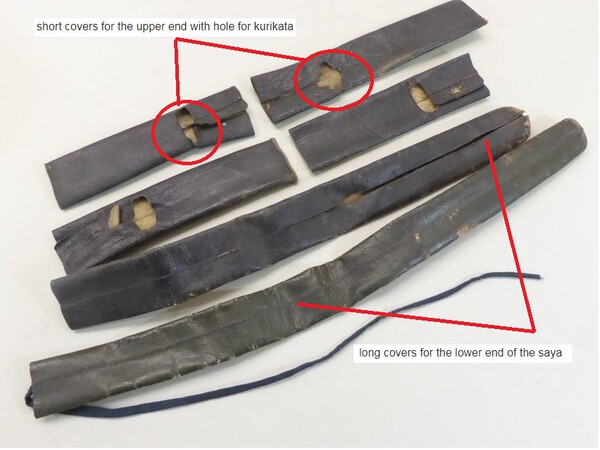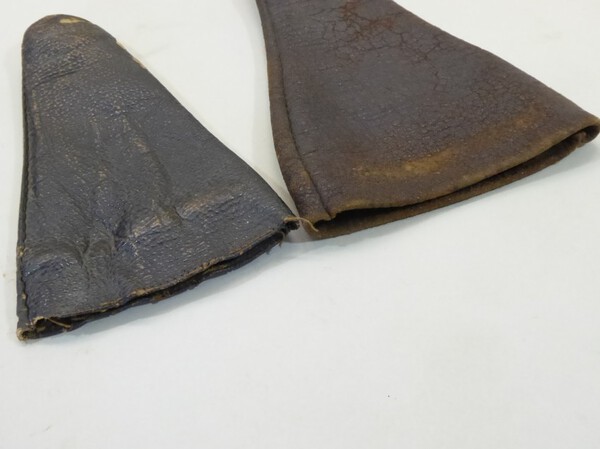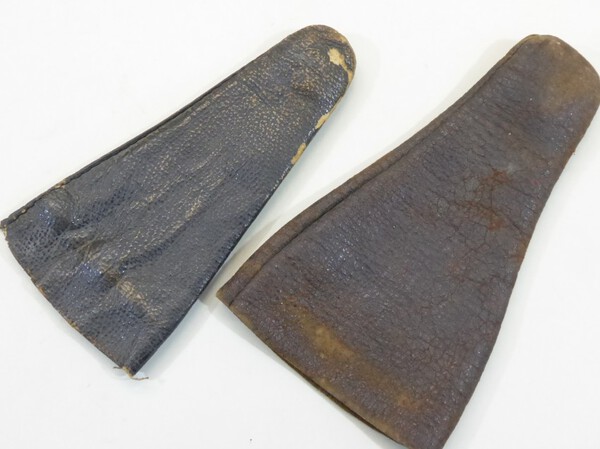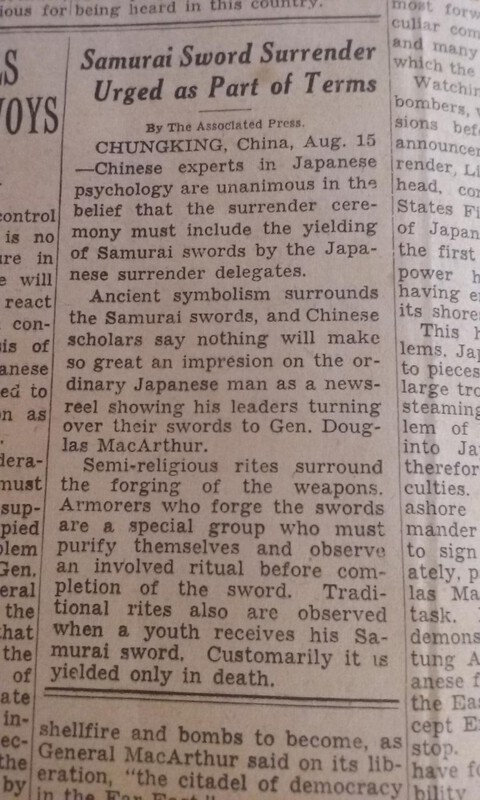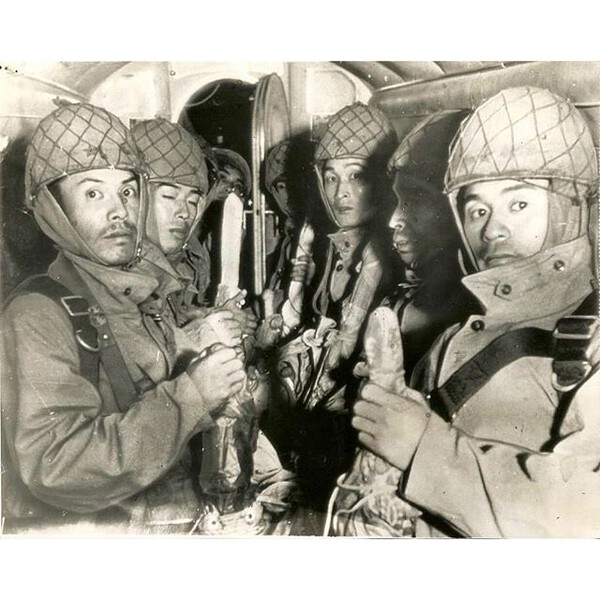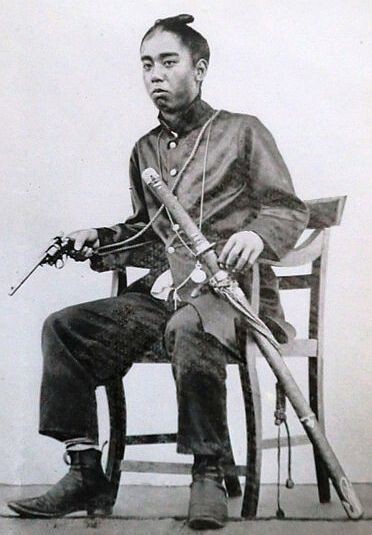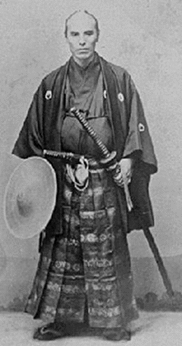-
Posts
1,690 -
Joined
-
Last visited
-
Days Won
11
Content Type
Profiles
Forums
Events
Store
Downloads
Gallery
Everything posted by Dave R
-
"" He got it on Okinawa, from pile of captured swords. ". Given a provenance like that, my first thought is a quick and dirty last ditch fix to take into combat, and the second is a quick and dirty assembly by the US military on Okinawa.... The latter I can well believe, we know some US personnel were sword hunting, what is more credible than rapid dismounts to check for valuable blades, and equally rapid reassembly!
-
Not the first time I have seen reused and mixed fittings on a legit' Gunto. There was a war on, and in the field you would use what was available, cannibalising other swords when necessary. So many damaged swords in the China campaign that the IJA sent out a repair team, who ended up having their tour extended because there were so many to deal with..... These do look to have been reassembled in the wrong order though.
-
Well you can't pin it exactly, but you can ascribe it to an era with some confidence. Traditional covers for saya and tsuka were made of (rape seed) oil tanned leather, rather like buckskin, that was lacquered to make it waterproof. The shape, and level of workmanship are also indicators of age, the old pieces are sewn with incredibly fine seams.. Fortunately they are not super collectable, but very difficult to fake. I have saya and tsuka covers, the tsuka often sold as yari (spear) sheathes... You also get a short open ended cover which is to protect the nice lacquer-work of your two saya from rubbing against each other as they sit in your obi. The tsuka bukuro are slip on's with no draw cord unlike the gunto covers so they can be thrown off in a hurry. Not many bother to collect them, but as you know by now, I am something of a nerd, and I like the accessories.
-

Seki-to with Hozon certification
Dave R replied to hillman's topic in Auctions and Online Sales or Sellers
It's the Ito on this one that has me gobsmacked! -
Traditional way of protecting the Ito, I have a couple of Edo period ones. Which oddly are usually cheaper that the WW 2 version.
-
Personal reminiscence of hearing about Ninja for the first time, 45 years ago, from an ex "Kings Shropshire Light Infantryman". He was talking about the riots, which he described as a civil war, in Mauritius 1968, and claimed that both sides were hiring in Japanese mercenaries called "Ninja"! He also described the use of throwing stars. This could have been total BS from an old soldier, and a rehash of films seen in Singapore where the regiment was based.... But it was a few years before I heard of either again. Wikipedia describes the fighting as being mainly between street gangs, so perhaps they were imitating what they had seen and heard of on screen. Just my two pennyworth. https://en.wikipedia.org/wiki/1968_Mauritian_riots
-
Another factor here is possibly a simple recognition of market forces. Showato of all kinds are now collectable enough to fetch serious money, and be faked. Papering them is a logical step to protect and support the market for the real thing.
-
A fake, but possibly now collectable in its own right as a piece of WW2 memorabilia. A lot of these made actually during the war by Aussie troops and US CB's to sell to the "next in" guys, who arrived too late for the battlefield pickups.
-
It is possibly worth remembering that the original demarcation between "traditional" and "non traditional" swords was made to preserve Nihonto from destruction by the post war occupation authorities. Now the only foreign troops in Japan are limited to rented bases in a few locations, and the occupation is officially at an end. Perhaps this distinction is now seen as less relevant than it was. As for why the swords were originally confiscated and then destroyed, see below.
-
I use the spray bottle, but spray the oil onto the tissue I use to wipe the blade.
-
I use this one, Kurobara tsubaki oil, ever since I saw that it was what Aoi Art used in their maintenance video for Nihonto. https://www.amazon.com/KUROBARA-Tsubaki-Japanese-Maintenance-Camellia/dp/B001TPFVHC Though I buy it via https://www.fine-tools.com/pflege.html because Amazon won't ship it to the UK. You can see it in use here... http://www.militaria.co.za/nmb/topic/21327-care-and-cleaning-by-tsuruta-san/
-
With you having a Showato blade the only issue with a mineral oil is that it is not good for the wooden liners. You might go over to Ballistol which is supposed to be ok for just about any material, or Kurobara camellia oil which is the one that is used on the high quality Japanese chefs knives. I use Kurobara on all my Japanese blades, Showato and Nihonto, it saves having too many bottles lying around.
-
Hand tools only... bitter experience has taught me that power tools enable mistakes to be made much faster than with hand tools.
-
-
Saleable.
-
My bad, I forgot that Mr Komiya is a documents man rather than a picture poster. You might find this link more informative... http://ohmura-study.net/952.html
-
The tsuba (guard) is almost certainly a replacement, wrong pattern for the rest of the sword, and definite signs of it being altered to fit. A lot more information about this type here... http://www.warrelics.eu/forum/Japanese-militaria/deflating-another-myth-type-3-army-officer-s-sword-expanded-version-584796/
-
Gunto mounts with a tsunagi turn up all the time on Ebay. If the blade is non traditional it has to be destroyed, so the mounts are left behind. In the other case, the blade is traditional and now lives in a shirasaya.
-

Possible to date this poor mumei katana blade?
Dave R replied to Logan09's topic in General Nihonto Related Discussion
Not what I meant mate. At $100 you cannot really lose. Not worth polishing ok, but you would have little trouble moving it on at no loss... to someone who just wants a "real samurai blade". I have in fact done just that myself with one of my "dogs", sold it to an online gamer who was delighted to have the real thing at an affordable price! -
I have one just like it, and have seen others online. I think they're just a plain economy, utility version for a sword in field mounts and meant for use not parade. As one sensei put it, "once a sword is drawn the the quality of the mounts becomes irrelevant". The only completely leather covered tsuka I have seen have been traditional Buke-Zukuri pattern, covered in leather as a quick and dirty fix to make them usable in the field.
-

Possible to date this poor mumei katana blade?
Dave R replied to Logan09's topic in General Nihonto Related Discussion
Are you saying that you bought this for $100? -
Wow, just wow! I am now awaiting the next instalment .
-
To the best of my knowledge, some very long mounts were made for katana during the Bakumatsu period, and were in fact regarded as a political statement of sorts. I wonder if this had an influence, as in long gunto being made in imitation of these, either as a homage, or as a reference to the politics of the time when Japan was under threat from the West..
-
My first nihonto was a wakizashi blade in a same covered saya, no tsuka or tsuba, cost me all of £4. 10 shillings, and decent swords in ok condition were £18. A couple of years later and they had gone up tenfold, and soon after ten times more again. That was then, this is now.
-
Would it be possible to see the whole sword, and it's saya?



